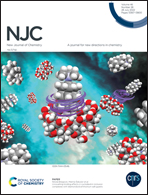Self-healing dynamic bond-based robust polyurethane acrylate hybrid polymers
Abstract
Herein, a self-healing hybrid polyurethane acrylate was prepared by solution polymerization of acrylic monomers (2-hydroxypropylmethacrylate/butyl acrylate mixture) in the presence of preformed polyurethane chains containing aliphatic disulfide bonds with terminal isocyanate groups. A good balance between the mechanical performance and self-healing capacities was also obtained by the precise regulation of the content of disulfide bonds along with the number of hard segments. The tensile strength of the impaired sample was recovered to 94.44% of the original value (22.68 MPa) under mild conditions (95 °C for 24 h). Our prepared samples exhibited an outstanding Young's modulus of 168 MPa compared to the reported self-repaired polyurethanes, in combination with good toughness. The dynamic evolution of the polymer structure with temperature due to the thermal response of the disulfide bond and the hydrogen bond was also studied via rheological experiments and stress relaxation tests. This self-healable material exhibited great potential in the industrial field thanks to its excellent mechanical properties and the simple preparation process.



 Please wait while we load your content...
Please wait while we load your content...